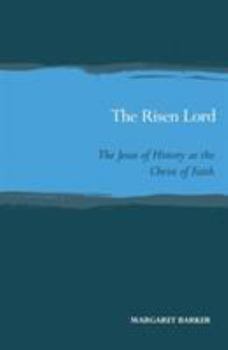Risen Lord
Redraws the map of the New Testament and Christian origins confronting much of the scepticism of recent New Testament scholarship to offer a new understanding of Resurrection, Christology, atonement and parousia.
Format:Paperback
Language:English
ISBN:0567085376
ISBN13:9780567085375
Release Date:October 1996
Publisher:T&T Clark
Length:454 Pages
Weight:0.49 lbs.
Dimensions:0.4" x 5.5" x 8.5"
Customer Reviews
1 rating
The Best Book about Jesus Written in Modern Times
Published by Thriftbooks.com User , 21 years ago
This book shatters all the modern "historical Jesus" myths without trying to preach or inspire. Rather than trying to dissect the minute details of Jesus' early life or what sect he may have belonged to, Barker concentrates on who Jesus believed himself to be and what great role he carried out. Barker uses the Bible and Jewish Apocryphal literature as the primary reference point in understanding Jesus. Anything else is either mere speculation or wasn't important enough for Jesus to convey to his followers. The belief of Jesus is Lord is the oldest and most important belief in Christianity which goes back to Jesus himself. It was not some pagan or neo-Platonic belief that was added later. The belief that Yahweh, the first-born of creation, and the God of Israel (not to be mistaken for Elohim or Almighty God), could manifest himself through certain extraordinary individuals after they experienced a mystical ascent to Heaven was a key element of a more ancient Judaism of the First Temple period. Such ascents became part of the Merkavah mystical tradition in Judaismand was experienced by Enoch, Melchizedek, Moses, Elijah, and Ezekiel who "put on" the spirit of the Lord (Yahweh) during their ascent. These ideas were alluded to in the Old Testament, especially in Daniel and Ezekiel and were clearly illustrated in the Enochian literature which was later suppressed by both Jews and Christians. Barker claims that Jesus' baptism was the pivotal moment of his life in which he experienced such an ascent and received the Spirit of the Lord. It was then that Jesus became the Son of God, the Lord, or the Word. Jesus later revealed this to a select group of disciples during the Transfiguration and later to a wider group during the Resurrection. Barker explains the importance of the ancient Temple symbology of the High Priest representing The Lord on the Day of Atonement in which he enters the Holy of Holies, representing Heaven to offer his own life to blot out the sins of Israel. The sacrificial blood was a substitute for the life of the Priest and the Priests eating the flesh of the sacrifice explains how Jesus used bread to symbolize his own flesh which he imparted to his disciples to become a new priesthood. Jesus understood that his primary role as The Son of God, or The Lord, was to become the Servant of God or High Priest who would offer his own blood (through martyrdom) as an atonement. Later, Jesus, like the Lamb in Revelation, would be enthroned as The Lord in Heaven to pass judgement on the wicked and to establish His Kingdom. Barker claims that the New Testament, especially Hebrews and Revelation, can only be understood in light of a more ancient form of First Temple Judaism which survived in certain apocalyptic circles in the first century C.E. The belief that "Jesus is Lord" is the most oldest and most fundamental belief of Christianity which Jesus believed of himself and which he imparted to his disciples.





